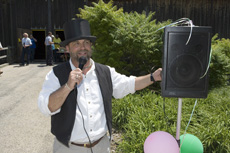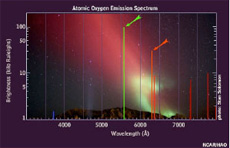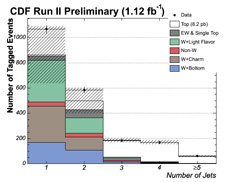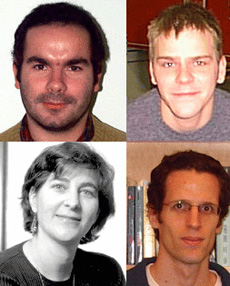|
Thurs., June 21
8:45 a.m. - 5:00 p.m.
Daughters and Sons to Work Day (DASTOW)
1:00 p.m.
ILC ALCPG Physics and Detector R&D Seminar - West Wing (WH10NW)
Speaker: N. Solomey, Illinois Institute of Technology
Title: Tagged Neutrons and the ILC Calorimeter R&D
2:30 p.m.
Theoretical Physics Seminar - Curia II
Speaker: O. Mena, Universitá di Roma I
Title: Landscape and Strings in Vacqua
2:30 p.m.
Particle Astrophysics Seminar - Dark Side (WH6NW)(NOTE DATE, LOCATION)
Speaker: D. Vanden Berk, University of Pittsburg
Title: Seeing the Sky Swiftly: Gamma-Ray Bursts and Beyond with the Swift Observatory
3:30 p.m.
DIRECTOR'S COFFEE BREAK - 2nd Flr X-Over
4:00 p.m.
Accelerator Physics and Technology Seminar - One West
Speaker: H. Damerau, CERN
Title: Longitudinal Emittance Control in the CERN PS
Fri., June 22
3:30 p.m.
DIRECTOR'S COFFEE BREAK - 2nd Flr X-Over
4:00 p.m.
Joint Experimental-Theoretical Physics Seminar - One West
Speaker: B. Knuteson, Massachusetts Institute of Technology
Title: Global Analysis of CDF High-pT Data
Click here for NALCAL,
a weekly calendar with links to additional information. |
Thursday, June 21
-Santa Fe black bean
-Sloppy joe
-Chicken cordon blue
-Sauteed liver & onions
-Baked ham & swiss on a ciabatta roll
-Assorted sliced pizza
-Crispy fried chicken ranch salad
*Carb Restricted Alternative
Wilson Hall Cafe Menu |
|
Thursday, June 21
Dinner
- Caponata
- Grilled lamb chops
- Canelli bean & celery root puree
- Blueberry cobbler
Wednesday, June 27
Lunch
- Antipasto salad
- Cassata
Chez Leon Menu
Call x4598 to make your reservation. |
|
|
BSS celebrates a safety milestone with picnic

Wayne Braun of Business Services Property and Inventory Control served as the master of ceremonies and announcer at the BSS Safety Picnic.
Last Wednesday, Business Services hosted a luncheon in the Kuhn Barn to celebrate their section's record-breaking commitment to safety in the workplace - nearly five years without a seriously compromising safety incident.
DART, or "days away, restricted, or transferred," is one of the criterion used by Fermilab to assess its safety performance. BSS surpassed their previous record of 389 days without a DART by a dramatic margin, for a total of 1,723 days without any lost work time.
The celebration included a gift card raffle and an outdoor picnic for the nearly 145 BSS personnel. Besides being a fun gathering, the safety picnic collectively honored BSS employees for taking the necessary precautions to stay safe.
"Because there's such a variety of work to do, there are many potential hazards," said Business Services section head David Carlson. "We're keeping peoples' minds on looking out for themselves and looking out for each other in the workplace."
-- Lauren Younis
|
Grid technology, relativity and the Aurora Borealis

Relativity-it's everywhere. Observers of the Aurora Borealis are witnessing a union between quantum theory and the theory of relativity. Visscher uses this image as a visible example of relativistic effects in atoms.
Image courtesy of the University Corporation for Atmospheric Research
If you've visited Helsinki or Anchorage, you may have seen visible proof of Einstein's theory of special relativity: the red color in the Aurora Borealis.
The atoms forming our atmosphere-mostly oxygen and nitrogen-don't move fast enough to display relativistic effects, but lightweight particles in these atoms-the electrons-do.
Read More
--Danielle Venton
|
From StarTribune.com
June 20, 2007
$200 million search for almost nothing
Those darn neutrinos. Billions of them pass through us every second. They are a clue in the search for understanding of the forces that hold the universe together. But are they willing to stop so we can take a look at them? No. Scientists have to try to nab them as they rocket past.
In what surely must be one of Minnesota's oddest distinctions, within a few years the state will be the only U.S. site with not one but two giant neutrino detectors. The first sits a half-mile underground in northeastern Minnesota in the former Soudan mine, where scientists have been trying to catch neutrinos fired from Chicago's Fermilab for two years.
Now, a new and bigger second detector that will cost about $200 million is planned for Ash River, an unincorporated settlement near International Falls and Voyageurs National Park.
Read more
|
From Chicago Sun-Times
June 20, 2007
Argonne goal: Study nukes without detonating them
EXOTIC QUEST | Bids for $550M lab to examine isotopes
Argonne National Laboratory hopes to build one of the world's most advanced science labs, where researchers would study everything from medical tests to nuclear bombs.
The Advanced Exotic Beam Laboratory would cost $550 million to build and $80 million a year to operate. It would have 300 employees.
The federal government, which is funding the project, will pick a site next year. Argonne, 25 miles southwest of Chicago, and Michigan State University are the leading contenders.
Read more
|
|
|
Top Crosses 10,000

Expected and observed number of events sorted by jet multiplicity requiring at least one tag. The top contribution is normalized to the measured cross section value of 8.2 pb.
Although the top quark was discovered at Fermilab more than ten years ago, scientists are still unveiling the physics behind this massive particle, the heaviest elementary particle yet discovered. One of the most important properties of the top quark is its cross section, the rate at which it is produced in the proton-antiproton collisions at the Tevatron. Theoretical calculations of the cross section have a precision of ~10 percent, so direct experimental results provide a stringent test of our understanding of elementary particle interactions.
Top quarks are dominantly produced in pairs, a process that is expected to occur once every 10 billion collisions at Fermilab. The challenge, then, is to overcome the large backgrounds and count the number of events consistent with top quark pair production. Physicists working at the CDF Collaboration have recently made the most precise single measurement of the top pair production cross section by improving both the yield of top-like events and the rejection of non-top events.
Top quarks decay almost immediately into lighter particles, the bottom quark and the W boson, which in turn decay into other particles. The event selection used in this measurement starts with the identification of one of the W bosons by its decay to an electron or a muon and a neutrino. Next, the bottom-quarks and quarks from the decay of the second W boson are identified as groups of collimated particles called "jets." The key of this measurement relies on the identification of the bottom quark using a technique, called b-tagging, that exploits its relatively long lifetime. About 340 events out of the nearly 10,000 top quark pairs produced so far at CDF have been observed. The result of 8.2+-0.5(stat)+-0.8(syst)+-0.5(lum) pb, is consistent with the Standard Model expectation for a top mass of 171 GeV/c2.
Learn more
 |
Clockwise from upper left : Joao Guimaraes da Costa, Daniel Sherman, Sebastian Grinstein, Melissa Franklin (all Harvard). |
|
|
Volunteer Cleanup Today
Keep Fermilab looking beautiful. Although today is DASTOW, Roads and Grounds still plans to have the scheduled Volunteer Cleanup today, June 21. We will meet at 11:45 a.m. on the ground floor, east side of Wilson Hall. Clean up area information will be provided upon meeting.
Sign up for Fermilab Blood Drive
Employees, users and summers students can now sign up for Fermilab's quartlerly blood drive, taking place Tuesday, June 26 and Wednesday June 27 from 8:00 a.m. to 2:00 p.m. Walk ins will be welcome. The blood drive will be located in the Wilson Hall ground floor training room. Call Diana at x3771 or Margie at x3411 or sign up online.
Vacancies in DOE Office of Science
The U.S. Department of Energy's Office of Science is seeking highly qualified candidates with outstanding scientific achievements to fill two important positions: Deputy for Programs and Associate Director of the Office of Science Biological and Environmental Research (BER) Program.
June Wilson Hall window washing
Window washing at Wilson Hall will continue through the end of June. Wilson Hall's interior will be washed this week. Please avoid walking through or moving barricades.
International Folk Dancing Thursday
International Folk Dancing will meet Thursday at 7:30 p.m. in Ramsey Auditorium. This will be the time and location for all summer meetings. Newcomers are always welcome, and you don't need to come with a partner. For more information call 630-584-0825 or 630-840-8194 or email.
|
|